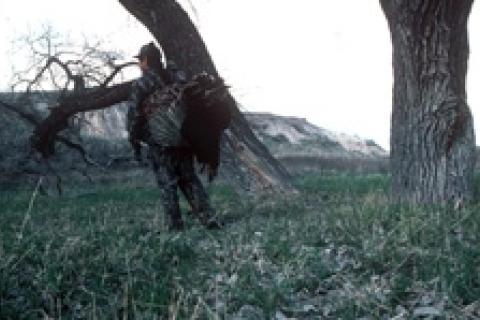
 Most turkey hunters associate spring gobbler season with mixed farm country and wood lots or vast reaches of national forest land covered with mature hardwood forests. But there's another kind of wild turkey habitat. And it offers an intriguing opportunity that you owe it to yourself to try at least once or twice in your lifetime.
Most turkey hunters associate spring gobbler season with mixed farm country and wood lots or vast reaches of national forest land covered with mature hardwood forests. But there's another kind of wild turkey habitat. And it offers an intriguing opportunity that you owe it to yourself to try at least once or twice in your lifetime.
That opportunity is hunting in mostly treeless western prairies where gobblers live along stream bottoms with stray cottonwoods and roam through the sagebrush and cactus searching for insects and tidbits to eat. It's habitat that you'd associate more with mule deer and antelope than gobblers. But the turkeys are there — big, beautiful Merriams that are a joy to hunt.
That was what drew me to Wyoming several years ago to the southeast corner of the state where I'd found a landowner who allowed hunting for a modest daily access fee. After paying the rancher and getting his advice on where he usually saw birds, I donned my camo and vest and slowly began working up the stream bottom.
Huge gobbler tracks marked the soft ground along the stream and I felt confident as I worked slowly along, calling periodically with a diaphragm and a box call. I also glassed upstream with binoculars trying to spot birds in the open.
It was mid-afternoon, and I didn't expect a lot of turkeys to be talking. But suddenly the sound of a deep gobble echoed through the scattered cottonwoods. I called again, but was met by silence.
Easing further upstream, I scanned ahead and soon saw a patch of fanned tail feathers 130 yards away. I could only see a portion of the bird, but with the optics I soon confirmed that it was a mature bird. Then I saw two more toms with him. Eventually they eased up the creek away from me.
Realizing they wanted to go in that direction and that my calls weren't going to change their mind, I circled wide through the surrounding sagebrush and then cut down into the bottom above them. There was no tree so I set up with my back against a dirt cliff where it dropped off into the bottom. I yelped softly on the mouth call, clucked twice, and then remained quiet.
To my surprise, something suddenly appeared in the high sagebrush above my position along the creek bottom. It was one of the gobblers, and he was staring directly at me.
There was no time to use a rangefinder, but I guessed the bird was 35 yards and squeezed off on the American Arms 12-gauge double's trigger. A 1 7/8 ounce load of Federal Premium copper-plated 6's found their mark and my Wyoming gobbler was down.
When he fell, the gobbler landed in the creek. After admiring the long beard on the 20-pound bird, I decided to pluck him right there with the feathers lose and the body wet and warm. Hoisting the dressed bird over my sounder, I headed back to the vehicle.
Halfway back, though, I froze in mid-stride. Another big gobbler caught my eye. Dropping into the tall grass, I pulled out the box, slipped a call in my mouth and began yelping and clucking. The turkey quickly worked my way, gobbling all the time. At 30 yards, I snapped a quick photo and watched him strut in front of me before he finally grew wary and drifted down the cottonwood creek bed.
It was a rich conclusion to a short but sweet Wyoming gobbler hunt. Give these sagebrush toms a try sometime and I think you'll agree they are a ball to hunt. They give spring turkey hunting a unique and appealing western flavor for a change of pace. Contact the Wyoming Game & Fish Department or local chambers of commerce to find ranchers who will allow fee hunting or book with a reputable guide.
- 3880 views

